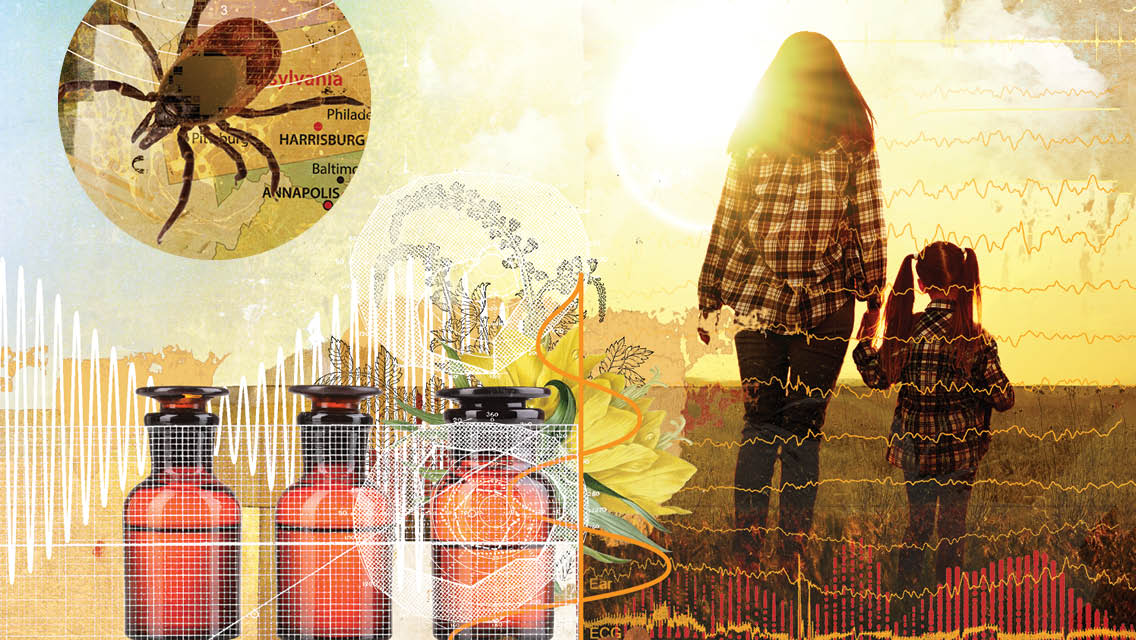
Pamela Weintraub writes enlightening piece on chronic Lyme
(Photo credit @ Experience Life)
Pamela Weintraub, a journalist, Lyme disease sufferer, and author of the book, “Cure Unknown: Inside the Lyme Epidemic,” wrote a recent article for Experience Life entitled, “A New Look at Chronic Lyme.” The article gives great coverage on chronic Lyme, featuring GLA writer, Jennifer Crystal. The article discusses important updates regarding the changes that are happening in the field of Lyme disease treatment. This includes the fact that many Lyme doctors now combine conventional medicine with more holistic treatments.
Weintraub writes:
“Today, many of these same practitioners have taken a different path, a multi-pronged approach that combines the judicious use of drugs with more natural therapies. And many patients with intractable illness are finally getting their lives back.
When problems cascade, you must treat the whole patient before the person can clear the infection, says Lyme expert Daniel Kinderlehrer, MD, whose Denver-based integrative medical practice focuses on tick-borne disease. He starts treatment by addressing sleep and pain issues. The problem has “become so much bigger than that infection; there are so many things that are wrong that you can’t treat by just treating the infection,” he explains. 'Even if you made the infection go away, you’d still have these other issues in the mix.’
Weintraub summarizes the Lyme divide like this: “The first features a straightforward infection, diagnosed early, with no additional immune issues…then there are those with Lyme (or a mix of tick-borne infections) who remain sick after the standard treatment.”
Read an excerpt of the article here:
A New Look at Chronic Lyme
Many physicians who treat tick-borne diseases now combine conventional medicine with gentler integrative strategies — and more long-term patients are getting well.
In the summer of 1997, Jennifer Crystal discovered a red, splotchy rash on her arm. A 19-year-old counselor at a camp in Maine at the time, Crystal had grown up in Connecticut; both states are epicenters of tick-borne diseases like Lyme.
Yet no one thought much of that rash — not even later, when, back at her Vermont college, she developed flulike symptoms: joint aches, fever, headache, and extreme fatigue. “I could barely get to class,” she recalls.
In the years that followed, the cluster of symptoms persisted. Crystal doggedly pushed through, completing a semester abroad, finishing college, and moving to Colorado to become a ski instructor — her lifelong dream — until it all became too much for her health. She ended up moving back to Connecticut to live with her family.
There, she sought the care of a naturopathic physician who suspected she had chronic fatigue syndrome. The condition is defined by exhaustion after exercise, un-refreshing sleep, concentration problems, and muscle pain lasting six months or more. Herbal treatments, an anti-inflammatory diet, and acupuncture barely made a difference.
Her illness remained a mystery until 2005, the day Crystal noticed two new bull’s-eye rashes emerge spontaneously. Finally, a clue.
A Lyme-disease test proved positive, which led her physician to diagnose other tick-borne co-infections. (Many persistent Lyme cases feature co-infections.) Months of IV antibiotics brought Crystal back to reasonable health. Believing she was cured, she took a job as an editor in Vermont.
Yet she remained fatigued, and working to support herself pushed her to the edge again. By 2007, at age 27, she was back home in Connecticut, in bed.
This time, with the help of her Lyme-disease specialist, Crystal approached her recovery differently. Along with antibiotics, supplements, and an anti-inflammatory diet, she pursued psychotherapy, integrative manual therapy, and neurofeedback. She regained traction, along with a new understanding that managing her illness would be an ongoing practice.
“I don’t consider myself sick,” Crystal says today — yet she also doesn’t consider herself cured. She has learned how to live with her chronic Lyme as well as symptoms from long COVID, and she is now documenting her experiences in a memoir called Long Hauler.
“I have needs from illness that come along with me, just the same way that diabetics have needs that they take along in their lives, to keep the illness in check.”
“I have needs from illness that come along with me, just the same way that diabetics have needs that they take along in their lives, to keep the illness in check.”
Crystal is one of up to 20 percent of Lyme patients whose symptoms are chronic, meaning they persist well past the initial course of treatment. In 2018, some estimates suggested there were more than 1 million Americans with chronic Lyme, or what the Centers for Disease Control and Prevention (CDC) calls post-treatment Lyme-disease syndrome (PTLDS).
Today we’re especially attuned to the long-haul fallout from COVID, where respiratory issues, brain fog, and depression hobble many patients for months. Those with chronic Lyme have faced similar hurdles for decades.
Doctors who are literate in chronic Lyme used to be rare. If you could find one, you’d likely be subjected to high doses of antibiotics and antimalarials in harsh regimens that might’ve lasted months or years.
The success of this approach was mixed. Some chronic-Lyme sufferers regained their lives but endured grueling side effects, including destabilized microbiomes (see “Why Your Microbiome Matters” to learn more about this all important ecosystem that lives in you). Others suffered side effects but did not improve.
Perhaps because so many chronic Lyme cases involve co-infection, these treatments often didn’t resolve the problem.
Today, many of these same practitioners have taken a different path, a multi-pronged approach that combines the judicious use of drugs with more natural therapies. And many patients with intractable illness are finally getting their lives back.
To read the full story on Experience Life, click here.







-2.jpg)